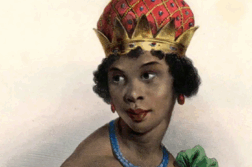THERE ARE GAY STORIES—mythologies, poetry, cultural artifacts—that set gay people apart, giving a tone to our music, a palette to our art, a philosophy to our wandering. What are the great themes and recurring mythologies—those metaphors of truth that are impossible to convey rationally—that can get at the great questions? To paraphrase Gauguin: Who are we? Where have we come from? Where are we going?
My argument is that there is something archetypal, natural, deep, philosophical, and cultural about being gay. There was a gay story being told from the beginning. There was a gay story here before gay people were here. We are remembering who we are. Stories take us home. They are the trail from the individual and the culture to the soul and beyond. As poetry, they bring words as symbols that connect our reality to ultimate reality, something that can only be done through a kind of transcendence, an experience of greater being.
Let us take a step back for a moment, into story itself. In his 2016 book Scatterlings: Getting Claimed in the Age of Amnesia, mythology scholar and storyteller Martin Shaw examined the place of myth and story in the modern world, a world that he feels has fallen away from storytelling into a kind of collective amnesia about who we are. The great philosophical questions go unanswered by most modern people, ignored in favor of the latest technology, the fashionable polemic, the recent swings of the economy, or the furious quest for originality as personality rather than as substance or “soul.” Here I’m talking about myth not as the opposite of fact but as each culture’s attempt to get at life’s deeper truths through story, philosophy, poetry, and religion. Myth as the hero’s journey, the initiation of youth into adulthood, the holy quest, the wandering and searching for home (say, that of Odysseus).
As I watch, and sometimes participate, in what happens with the current protests, I wonder what is being sparked in me; what stories or deeper currents of feeling are being stirred? I connect with Black Lives Matter in many ways, but most essentially through my struggles as a gay man: struggles for rights, for recognition, and for meaning. This struggle was always twofold for me: the revolution that is televised (AIDS, marriage, etc.) and the internal revolution that is not televised (who am I, where have I come from, where am I going?).
What, then, is our gay story and struggle all about? What are our essential myth(s), the dominant themes or values or essences that we bring, not so much as over-the-top personalities but as gifts: the inborn talents or presence that each individual gives to the whole? What is our unique contribution to the world that make us (or anyone) valuable? What is the struggle for rights and recognition truly about? Turning to Western cultural history, we can go back as far as the ancient Greeks, to the start of it all. Plato’s Symposium speaks openly of same-sex love as a higher form of love, a devotion to the ideal of Love itself. Present at the symposium are two actual gay lovers, the celebrated playwright Agathon and his man Pausanias, but the discussion is not so much about person-to-person relationships as it is about Love as such. A certain kind of same-sex love is eventually defended by Socrates as embodying the ideal form of love, which entails both partners’ dedication to a higher purpose or mission. The Sacred Band of Thebes, an elite squad of 150 men representing the leaders in the Theban army in around 400 BCE, is offered as an example of the dedication that men can achieve through the emotional bonds of comrades in arms. Over two millennia later, Edward Carpenter—social philosopher, revolutionary, and love partner of Walt Whitman—wrote the following: “It certainly does not seem impossible to suppose that as the ordinary love has a special function in the propagation of the race, so the other has its special function in social and heroic work and into the generation not of bodily children but of those children of the mind—the philosophical conceptions and ideals which transform our lives and those of society.” He went on to say: “But while the Uranian [today’s “gay”] temperament has, in cases, specially fitted its possessors to become distinguished in art or education or war or administration and enable them to do valuable work in these fields, it remains perhaps true that above all it has fitted them, and fits them, for distinction and service in affairs of the heart.” Thus the story of our particular form of love as having a greater purpose finds itself being told again, in only slightly different language, from the Greeks into modern times. Carl Jung, the 20th-century psychologist and philosopher, labeled occurrences of similar motifs, instincts, and ways of being over time as “archetypes.” What we call “gay” may be seen as an archetypal phenomenon, a way of being, a kind of existence found in different forms and manifestations in many different times and places. The gay story may have been told, or hidden, by our great-great-great grandparents. In the “Calamus” poems, Walt Whitman renders in beautiful verse what he would later come to call “adhesive” love. Other Whitman poems that touch on this theme include “We Two Boys Together Clinging,” “In Paths Untrodden,” “For You O Democracy,” “A Glimpse,” and “To a Western Boy,” which includes some of Whitman’s stories about democratic love, indeed a force of democracy itself: men lying beside one another at night while working shoulder-to-shoulder during the day. For Whitman, adhesive love, or the love between men, was stronger than the more traditional “amative” love, which was prescribed by society and thus conventional rather than natural or spontaneous. Moving into the 20th century, Harry Hay, one of the founders of the modern gay movement, stated the following: “We homosexuals are a minority, who share each other’s dream, whether we speak the same language or not, who share a common psychic vision whether we share the same cultural make-up or not, all the days of our years.” He contrasted this vision with the essence of more conventional men: The aggressive competitiveness, taken for granted as an eternal verity by our heterosexual parent society, in us redirects, under the guidance of the blueprint of our minority nature. In us, this genetic redirection transforms our perceptions of unconsciously inherited animal maleness or femaleness into appreciations of—nay even a life-long passion to call forth, to call into being—the grace and tenderness behind that competitive strength, the humility and compassion behind that territorial ruthlessness.* Harvard biologist E. O. Wilson, in The Social Conquest of Earth (2012), suggests that gay people may have survived evolutionary pressures precisely because they were carriers of the gene for altruistic behavior in humans. Stanford biology professor emeritus Joan Roughgarden suggests in Evolution’s Rainbow: Diversity, Gender, and Sexuality in Nature and People (2013) that gay beings throughout nature (not just humans) may be carriers of the “cooperation principle” as opposed to the more commonly discussed competitive principle. Achilles finally entered the battlefield to avenge the death of his lover Patroclus, anticipating Whitman’s To A Western Boy. Even Zeus had a turn at it upon beholding the beauty of the mortal boy Ganymede, being so awestruck that he lifted the lad to Olympus to join the gods. And it’s not just the Greeks, or 19th-century American and English philosophers and poets, or modern Western biologists, who recognize this phenomenon. In a 1993 interview titled “Gays: Guardians of the Gates,” Malidoma Some, an African tribal elder and scholar educated at the Sorbonne, called gay people “gatekeepers,” citing a traditional social role of his tribe. The Dagara people regard everyone according to their vital contribution to the tribe, Some explains. Gay people, with their understanding of both the masculine and the feminine, are seen to have an understanding of both this world and the other world, that of the ancestors, gods, and creative energies. Gay people have a different vibrational frequency, according to the Dagara, a unique perspective from two worlds, one that’s vital to the survival of the tribe. Across continents and across time, we find words, images, myths, sciences, and philosophies responding again and again to this “gay soul” that seems to present itself in so many cultures and times in human history. One of the Navajo terms for gay men was “men not made for war,” resonating with Edward Carpenter’s “distinction and service in affairs of the heart.” Robert Mapplethorpe’s photographs were the cultural fulfillment of Caravaggio’s Renaissance perspectives and passions, with both artists manifesting what cultural critic Lewis Hyde identified as a gay connection to the trickster archetype, which in turn he associates with the creation of new culture. Whether as great artists and visionaries unshackled from normal social roles, as quiet empaths sensitive to “the whisper,” or as wounded healers, loving warriors, democratic idealists, or even White Party ravers, gay people come with a unique destiny, a special offering that just might be essential to human survival. As I sit in semi-quarantine, having returned from the streets (masked) where protests were taking place in my city (L.A.), I’m reminded that for me it goes back to one’s essential story; that, at a certain fundamental level, protest is always about the right to freely discover who we are, where we have come from, and where we are going. There is one protest, and I take to the streets for that. I found this out through my own gay struggle, and how that connects me to the struggles of others. Black Lives Matter stirs the revolutionary in me. Gayness matters more to me now than ever, and I’m reminded of W.E.B. DuBois’ The Souls of Black Folks as a fundamental, passionate reminder of soul, of heart, of something that can hide or be torn away for a time by others, but that must eventually return. In one of the old stories, the gods try to figure out where to hide the secret of life so that only those with courage can find it. As they discuss various hiding places, such as the deep sea, the dark forest, and the furthest cave, they realize that people’s greed will eventually colonize every location they can think of. Finally, the wisest of the gods says to “hide it inside men’s hearts, for they will never look there.” We gays do look there, and so hold out a promise, perhaps still only a faint possibility, of finding inside men’s hearts that long-awaited secret of life, the longed-for freeing of the soul through the risk of love. * As quoted in Radically Gay, by Will Roscoe. Beacon Press, 1996.
Brian Gleason, PhD, a Jungian-oriented psychotherapist in private practice in L.A., has contributed to White Crane Journal, Psychological Perspectives, and The L.A. Blade.He is executive director of Rise Up And Shout, an LGBT youth mentoring organization.





Discussion1 Comment
This is fantastic. Thanks to Brian Gleason for a thoughtful examination of “the gay soul,” and it is especially relevant at the turn of this new decade, the end of the Trump era, and hopefully, the final clutches of the pandemic. Who we are, where have we come from, and where are we going? Indeed.